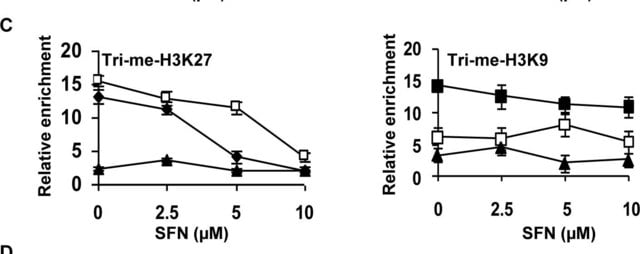일반 설명
Anti-trimethyl-Histone H3 (Lys4), Cat. No. 07-473, is a rabbit polyclonal antibody that detects Histone H3 trimethylated on lysine 4 and is tested for use in ChIP, Dot Blot, Immunocytochemistry, and Western Blotting.
Purified rabbit polyclonal antibody in buffer containing 0.1 M Tris-Glycine (pH 7.4), 150 mM NaCl with 0.05% sodium azide
특이성
This rabbit polyclonal antibody specifically detects Histone H3 trimethylated on lysine 4 (H3Kme3).
면역원
Epitope: Trimethylated (Lys4)
KLH-conjugated linear peptide corresponding to 10 amino acids from the N-terminal region of human Histone H3 trimethylated on lysine 4.
애플리케이션
ChIP Analysis:
An independent lab has shown that this antibody performs in chromatin immunoprecipitation (ChIP).
Dot Blot Analysis: A 1:10,000 dilution from a representative lot detected trimethyl-Histone H3 (Lys 4 ) in an Absurance Histone H3 Antibody Specificity Array (Cat. No. 16-667) and an Absurance Histone H2A, H2B, H4 Antibody Specificity Array (Cat. No. 16-665).
ChIP-seq Analysis:
Chromatin immunoprecipitation was performed using the Magna ChIP HiSens kit (cat# 17-10460), 1 µL Anti-trimethyl-Histone H3 (Lys4) antibody (cat# 07-473) , 20 µL Protein A/G beads, and 1e6 crosslinked HeLa cell chromatin followed by DNA purification using magnetic beads. Libraries were prepared from Input and ChIP DNA samples using standard protocols with Illumina barcoded adapters, and analyzed on Illumina HiSeq instrument. An excess of eighteen million reads from FastQ files were mapped using Bowtie (http://bowtie-bio.sourceforge.net/manual.shtml) following TagDust (http://genome.gsc.riken.jp/osc/english/dataresource/) tag removal. Peaks were identified using MACS (http://luelab.dfci.harvard.edu/MACS/), with peaks and reads visualized as a custom track in UCSC Genome Browser (http://genome.ucsc.edu) from BigWig and BED files. The highest 25% of peaks identified in the 07-473 dataset showed 99% overlap with peaks identified in the ENCODE H3K4me3 BROAD Histone track for HeLa S3.
Anti-trimethyl-Histone H3 (Lys4), Cat. No. 07-473, is a rabbit polyclonal antibody that detects Histone H3 trimethylated on lysine 4 and is tested for use in ChIP, Dot Blot, Immunocytochemistry, and Western Blotting.
Research Category
Epigenetics & Nuclear Function
Research Sub Category
Histones
품질
Evaluated by Western Blotting on HeLa acid extracted nuclear preps (positive) and recombinant Histone H3 (negative).
Western Blotting Analysis:
1:5,000 – 1:10,000 dilution of this antibody was used to detect trimethylated-Histone H3 (Lys4) in HeLa nuclear acid extracts.
표적 설명
Histone H3.1t (UniProt: Q16695; also known as H3/t, H3t, H3/g) is encoded by the HIST3H3 (also known as H3FT) gene (Gene ID: 8290) in human. Histones are highly conserved basic nuclear proteins that are responsible for the nucleosome structure of chromatin in eukaryotes. They play a central role in transcription regulation, DNA repair, DNA replication and chromosomal stability. Two molecules of each of the four core histones (H2A, H2B, H3, and H4) form an octamer, around which DNA is wrapped in repeating units, called nucleosomes, which limits DNA accessibility to the cellular machineries that require DNA as a template. Histone H3 features a main globular domain and a long N-terminal tail, which protrudes from the globular nucleosome core and can undergo several different types of epigenetic modifications that influence cellular processes. The N-terminal tails of histone proteins are subject to posttranslational modifications, including phosphorylation, acetylation, and methylation, which recruit downstream regulatory factors, influence chromatin structure, and are critical determinants of transcription. Histone H3 can undergo acetylation on several lysine residues in the histone tail by histone acetyltransferases. Acetylation is generally associated with transcriptional activity and methylation of lysine and arginine residues can either activate or repress depending on the residue modified. Trimethylation of histone H3 is one of the most studied epigenetic marks. H3K4me3 modifications are reported to occur consistently at transcription start sites and H3K4me3 domain is associated with higher transcription activity and cell identity in pre-implantation development and in the process of deriving embryonic stem cells from the inner cell mass and trophoblast stem cells from the trophectoderm. (Ref.: Sharifi-Zarchi, A., et al. (2017). BMS Genomics. 18; Article 964; Liu, X., et al. (2016). Nature. 537(7621); 558-562).
물리적 형태
Affinity purified
Affinity purified rabbit polyclonal antibody in buffer containing 0.1M Tris-Glycine (pH 7.4), 150mM NaCl with 0.05% sodium azide.
저장 및 안정성
Stable for 1 year at 2-8ºC from date of receipt.
분석 메모
Control
HeLa nuclear extracts
법적 정보
UPSTATE is a registered trademark of Merck KGaA, Darmstadt, Germany
면책조항
Unless otherwise stated in our catalog or other company documentation accompanying the product(s), our products are intended for research use only and are not to be used for any other purpose, which includes but is not limited to, unauthorized commercial uses, in vitro diagnostic uses, ex vivo or in vivo therapeutic uses or any type of consumption or application to humans or animals.











